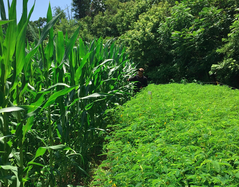|
The Greek philosopher Heraclitus was channeling his inner taxonomist when he declared, “everything is in flux.” Depending on who you ask, taxonomy as a field precariously teeters between being either the foundation of all other biological sciences or the most esoteric debate topic two scientists can choose. Scientists rely on taxonomists to draw the lines between the species that we study so we can all be on the same page while we study them (imagine trying to plan a trip to the zoo without names for the animals). As Dr. Jason Mottern explained during the last Entomology Department colloquium of 2016, these lines are often drawn in pencil.
 Figure 1. Can field corn (left) benefit from insects attracted by partridge pea (right)? (Photo credit: Lauren Hunt) Figure 1. Can field corn (left) benefit from insects attracted by partridge pea (right)? (Photo credit: Lauren Hunt) Conservation biological control – a fancy term for the support of beneficial insects in a cropping system to enhance natural pest control - has long been of interest in organic agriculture. Lauren Hunt of the Department of Entomology’s Hooks Lab has been investigating the potential for conservation biological control in organic field corn using partridge pea (Chamaecrista fasciculata) to attract and support insects that feed on and parasitize pests. Many predators and parasitoids, collectively called beneficial insects or natural enemies, need nectar resources offered by flowers to successfully develop and reproduce. Partridge pea offers these nectar resources to insects in the form of flowers and via special glands, termed “extrafloral nectaries” located at the base of the petioles. These nectaries are particularly attractive to wasps known to parasitize a variety of insect pests, including stink bugs, corn earworms, and corn borers – common pests of corn and key pests in Lauren’s study. Post-doc Christopher Taylor (Hamby Lab), graduate student Veronica Johnson (Hooks Lab), and Professor Emeritus Dr. Galen Dively have a new publication titled, "Assessing the use of antimicrobials to sterilize brown marmorated stink bug egg masses and prevent symbiont acquisition" in Journal of Pest Science. You can read the abstract below and find the full feature here. Congratulations on your achievement!
The kudzu bug (Megacopta cribraria) (Family Plataspidae) (Fig. 1) has become a widespread invasive pest in the southern United States since it was first detected in Georgia in 2009. This small, round bug is closely related to stinkbugs (Pentatomidae) and has plagued soybean farmers under non-treatment and high density conditions with yield losses as high as 59%! It feeds on the soybean plants’ leaves and stems with its piercing-sucking mouthparts, which can affect the number of seeds per pod and overall seed weight. The overall damage is astounding, especially when considering all kudzu bugs in North America originated from a single female bug from Japan. Luckily, many studies have been done to track and monitor this pest, such as those done by Jessica Grant.
|
Categories
All
Archives
June 2024
|
Department of Entomology
University of Maryland
4112 Plant Sciences Building
College Park, MD 20742-4454
USA
Telephone: 301.405.3911
Fax: 301.314.9290
University of Maryland
4112 Plant Sciences Building
College Park, MD 20742-4454
USA
Telephone: 301.405.3911
Fax: 301.314.9290

 RSS Feed
RSS Feed




